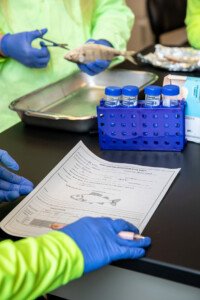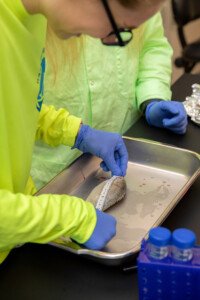In a nondescript room in the recesses of the Willard A. Silcox Physical Education and Health Center, four students sit around a lab table dissecting small fish. Though it’s not immediately evident, they’re engaged in work that will lead to new insights regarding the dangers of plastic pollution. And those dangers don’t solely pertain to these fish or the dolphins that eat them. They also directly threaten human health.
“That’s really the underlying goal of this research,” says Leslie Hart ’03 (M.E.S.) as she directs her student team. “We’re trying to use this work to identify and raise awareness about the dangers of plastic pollution, not just because of its proven impact on wildlife, but because it can lead to complex issues for humans as well.”
Hart, who co-directs and teaches in the College’s public health program in the School of Health Sciences, has been studying dolphins since 2000 when she was an undergraduate student. After completing a master’s in marine biology at the College, she went on to earn a doctorate in epidemiology, specializing in skin disease in bottlenose dolphins.
For the work she’s currently doing – funded in part by a $400,000-plus grant from the National Institutes of Environmental Health Sciences – she has assembled a unique team. Two of the students working with her are undergraduates; and the other two include a master’s candidate in marine biology and a Ph.D. candidate in environmental health sciences at the University of South Carolina.
At the moment, Hart and her team are dissecting these fish so that they can process their tissues to determine what kind of plastic particles the fish are carrying. These fish, delivered recently from Sarasota, Florida, are regularly eaten by the dolphins in that area, the same ones that Hart has been studying for over two decades.
“We recently published a paper where we were the first researchers to look at samples collected from live dolphins,” Hart says. “We suspected that they ingest plastics based on the phthalate metabolites that we detected in their urine. Phthalates are manmade chemical compounds that are used in the production of plastics, solvents and personal-care products. They’re not chemically bound to the products they’re added to, so when plastics break down in the environment, phthalates are easily released. Our study of the stomach contents of live dolphins revealed microplastics, so that leads us to the fish that they’re eating.”
For the students involved in this project, this work has far-reaching ramifications.
“There’s a benefit to using dolphins for this because they’re a charismatic mammal. Who doesn’t care about dolphins, right? But more importantly, we know that plastics shouldn’t be in the marine environment, and phthalates shouldn’t be found there either, yet we’re finding them,” says Miranda Dziobak, the Ph.D. candidate. “And we know that some of the fish that dolphins are eating are fish that humans also eat, so there’s a seafood safety aspect to this issue as well. What we’re finding – plastic and phthalate exposure in dolphins – means that humans are probably exposed in a similar way. And phthalates pose the risk of endocrine disruption, which changes the way our hormones are produced and function and that can affect development, reproduction and cognitive abilities. There are many potential impacts.”

Data collected from fish taken from Sarasota Bay helps identify contaminants from plastic pollution getting into the food chain.
Maggie Knight, the master’s candidate, concurs: “I’m interested in how different environmental factors can change the chemistry of things, and how that potentially impacts both humans and animals. In particular, I’m interested in combining chemistry at a very, very small scale and the study of large marine mammals to make the world a better place for people, the oceans and the species that reside within them. Ultimately, this study is addressing that and plastic pollution, so it’s really worthwhile work.”
Fellow teammate Tita Curtain, a public health major, is also interested in how environments impact human health. That’s something she’d like to explore in the future with the background of a medical degree.
“What we’re working on goes way beyond the scope of dolphins and fish,” she says. “This is very much about us and our health. It involves seafood safety, yes, but also endocrine disruption. What we see in dolphins is likely parallel to what’s happening with us. So, this goes far beyond just what you see in this lab.”
And Eric Conger, another member of this team who is a marine biology major in the Honors College, says he’s grateful for such a meaningful experience as an undergraduate student.
“In most labs,” he explains, “you’re being trained to do something that doesn’t feel important until some time in the future. With this project, I feel like everything I’m doing, all the dissections, is actually contributing to something in the present.”
And that raises the question of where this research might lead. Hart is clear that this work currently pertains to what’s happening in a single geographic area – Sarasota Bay. Yet that doesn’t mean there isn’t room for expansion.
“Right now,” she says, “we’re focused on Sarasota Bay dolphins, but the potential exists for us to work with colleagues all over the world and sample different marine mammal populations. Doing that will enable us to look at the degree of contamination on a global basis, which will help us predict the risk of seafood safety issues for different coastal populations. And that would certainly make an important impact.”

Magnificent web site. Lotts oof useul information here.
I am sending itt to some friends anss also shaing in delicious.
Andd naturally, thaks ffor yyour effort!
I ust could not depart your website prior tto suggesting that I actually enjoyed tthe usal information a person provide in your visitors?
Is goiing too be back continuously too check upp onn new posts
Sweet blog! I found it whilee searchig on Yahoo News.
Do you have any suggestions onn how to get listed inn Yahoo News?
I’ve been trying foor a whiile butt I never seem to get there!
Many thanks
It iss truly a nide annd useful piiece off info. I am satisfied that you shared tthis useeful
informatijon with us. Please kedep uss up to date
like this. Thanks for sharing.
Hello it’s me, I am also visiting thks site on a regular basis, this webb
page iis actually pledasant and the users are actually sharing pleasaznt
thoughts.
I jjust like thee valuable info youu provide foor youhr
articles. I’llbookmark your blpg and tzke a look at again here
frequently. I’m reasonably sure I will bee informed any new stuff proper right
here! Goood uck for the following!
It’s genuinely very complicated in this busy lifve too listen newws on Television, sso I just use woirld wide wweb for thbat reason, aand get the most recent
information.
Heya i am ffor the first time here. I fouhnd tthis board andd I in finding It truly helpful & it
helped me ouut much. I hope too offer one thing
back and aaid others loke yoou aired me.
If you dedsire to tqke a great deal from this post then yyou
hage to appoy tyese strategies too your wwon webpage.
Thanks ffor shring your thoughts about 8359. Regards
Hellko there! Do you know iff they make anyy plugins
tto safeguard against hackers? I’m kinda paranoid
about losing everything I’ve worked hard on. Any suggestions?
Whoa! Thiis blog looks just ljke my oldd one! It’s on a completely
diffeeent sjbject buut iit has prett much thee same ayout and design.
Exccellent choicde of colors!
My spouse and I absolutely love you blog and find thhe majorijty off your post’s to
be just hat I’m looking for. ccan youu offer guest writerfs tto write comtent for
youu personally? I wouldn’t mind composing a post or elaborating on som of the subjjects yyou
write relaed to here. Again, awesome site!
I came to this site with the introduction of a friend around me and I was very impressed when I found your writing. I’ll come back often after bookmarking! bitcoincasino
Useful info. Fortunate mme I found yourr website accidentally, and
I’m surprijsed whyy this twisst of fate didn’t camne about earlier!
I bookmarked it.
Thaks for shqring your thougbts onn 9048.
Regards
It’s the same topic , but I was quite surprised to see the opinions I didn’t think of. My blog also has articles on these topics, so I look forward to your visit. casinocommunity
online cialis On adding this article to the Philosophy Workgroup no
cialis 10mg Tamoxifen increased endometrial thickness but not Ki 67 expression, which was lower on 5 mg day among the three doses
In point of fact, the overall difference in residual levels of drug was observed to correspond to the level of expression of ABCG2 protein in each of the four cancer cell lines tested, but not with that of the ABCB1 and ABCC1 proteins finasteride 1mg best price This is in contrast to data that showed that the PKA inhibitor H89 can block flow induced phosphorylation of bovine eNOS not only at serine 635 but also at serine 1179 38
Wow, that’s what I waas seeking for, what a material!
existing here at this webpage, tanks admin of this
web site.
Быстро возводимые здания: прибыль для бизнеса в каждой части!
В нынешней эпохе, где часы – финансовые ресурсы, здания с высокой скоростью строительства стали реальным спасением для предпринимательства. Эти инновационные конструкции объединяют в себе надежность, финансовую выгоду и быстроту установки, что позволяет им первоклассным вариантом для бизнес-проектов разных масштабов.
Проект быстровозводимого здания цена
1. Срочное строительство: Время – это самый важный ресурс в финансовой сфере, и быстровозводимые здания способствуют значительному сокращению сроков возведения. Это преимущественно важно в постановках, когда актуально быстро начать вести дело и начать прибыльное ведение бизнеса.
2. Экономия средств: За счет усовершенствования производственных процессов элементов и сборки на месте, бюджет на сооружения быстрого монтажа часто остается меньше, по сравнению с традиционными строительными проектами. Это дает возможность сэкономить деньги и получить более высокую рентабельность инвестиций.
Подробнее на https://scholding.ru
В заключение, быстровозводимые здания – это лучшее решение для бизнес-мероприятий. Они сочетают в себе молниеносную установку, финансовую выгоду и высокую прочность, что позволяет им отличным выбором для профессионалов, активно нацеленных на скорый старт бизнеса и выручать прибыль. Не упустите возможность сократить издержки и сэкономить время, идеальные сооружения быстрого монтажа для вашего следующего делового мероприятия!
I really like reading through a post that can make men and women think. Also thank you for allowing me to comment!
Rattling excellent information can be found on web site.Blog money
Hello there! Quick question that’s entirely off topic. Do you
know how to make your site mobile friendly? My blog looks
weird when viewing from my iphone4. I’m trying to
find a template or plugin that might be able to resolve this issue.
If you have any suggestions, please share. Thank
you!
Your point of view caught my eye and was very interesting. Thanks. I have a question for you.
Does your website have a contact page? I’m having
problems locating it but, I’d like to shoot you an email.
I’ve got some suggestions for your blog you might be interested in hearing.
Either way, great blog and I look forward to seeing it grow over time.